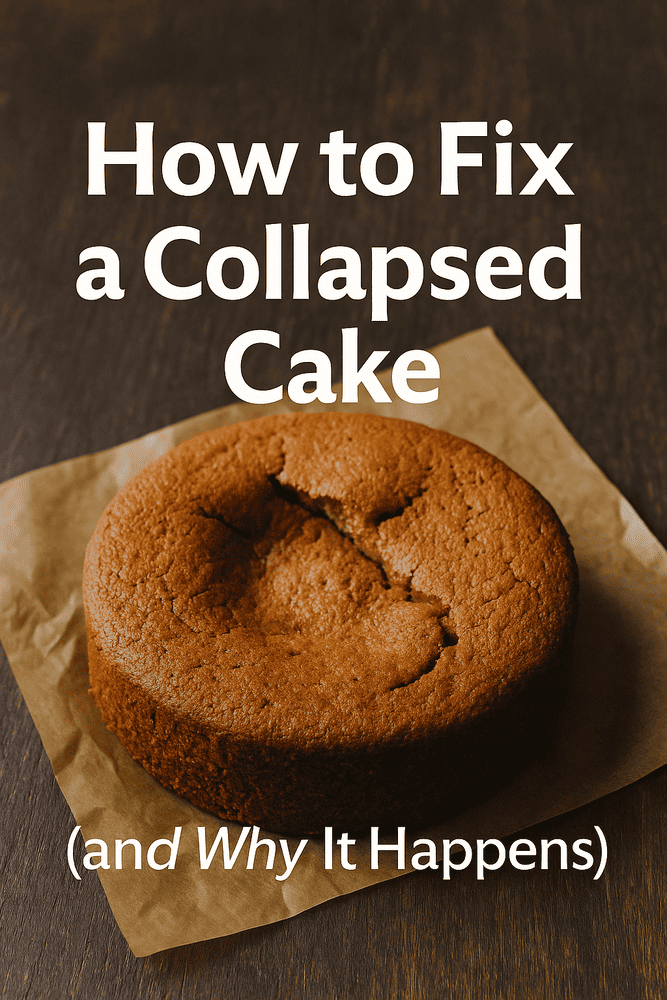You followed the recipe carefully, mixed the batter with love, preheated the oven, and watched your cake rise with hope… But when you opened the oven door — there it was: a sunken, deflated, or even caved-in cake. Frustrating, isn’t it?
This is one of the most common — and disheartening — baking issues. But it doesn’t have to ruin your day. In this article, you’ll learn why cakes collapse, how to prevent it from happening again, and most importantly, how to salvage your cake so you don’t waste your efforts (or ingredients).
This guide connects directly with previous posts, like oven temperature control (#10), understanding eggs in baking (#11), ingredient structure and moisture (#3 and #7), and even ingredient substitutions (#14). Together, we’ll turn frustration into insight — and failed cakes into creative success.
Why Do Cakes Collapse? 6 Common Causes
1. Opening the oven too early
This is the number one culprit. If you open the oven door before the cake has set (usually before 25–30 minutes), the sudden drop in temperature can deflate the batter mid-rise.
2. Incorrect oven temperature
If your oven is too cool, the cake won’t rise properly. If it’s too hot, the cake may puff up too quickly and then collapse once out of the oven. (See article #10 for more on this.)
3. Weak structure in the batter
Using too little flour, too much fat, or a poor ratio of wet to dry ingredients can result in a cake that can’t support itself. This is common in gluten-free or oil-heavy recipes.
4. Too much or too little leavening
Baking powder and baking soda must be carefully measured. Too much causes a rapid rise followed by collapse, while too little can prevent a rise altogether.
5. Improper mixing technique
Overmixing can develop too much gluten and create a dense texture, while undermixing leaves pockets of dry flour or uneven ingredients that compromise structure.
6. Handling the cake too soon
Moving or removing the cake from the pan while it’s still hot and fragile can cause it to cave in. Let it cool for at least 10 minutes before attempting to transfer.
How to Prevent Your Cake from Sinking
Let’s stop the problem before it starts. Follow these pro tips:
- Always preheat your oven for 10–15 minutes before baking.
- Use an oven thermometer to verify that your oven’s internal temperature matches the setting.
- Resist the urge to open the oven door too soon — wait at least 25–30 minutes.
- Stick to trusted recipes when testing new techniques.
- Follow mixing guidelines: mix gently and only until the ingredients are combined.
- Let the cake cool slowly in a stable environment, away from drafts and vibrations.
These practices are extensions of what we covered in articles #1, #10, and #15 — and will improve all your future bakes.
How to Save a Collapsed Cake
Good news: just because your cake sank doesn’t mean it’s ruined. Here are several clever and tasty ways to give it a second life:
1. Trim and fill
If only the center collapsed, you can slice off the top and level the cake. Add a delicious filling like whipped cream or ganache and turn it into a layered naked cake.
2. Make cake-in-a-jar
Crumble the cake and layer it in jars with mousse, custard, or fruit. These make for elegant, portioned desserts that can even be sold (as discussed in article #35).
3. Turn it into a trifle
Layer the broken pieces with cream, fruit, and syrup in a glass bowl. It becomes a beautiful dessert with a rustic charm.
4. Roll cake pops
Mix the crumbs with a bit of frosting or condensed milk, shape into balls, and dip in melted chocolate. Kids love them — and so do adults.
5. Serve with warm sauce
Top the cake with caramel, chocolate, or fruit sauce and serve with ice cream. The softness won’t matter — it’ll taste like a gourmet dessert.
When to Toss It
There are cases when the cake can’t be saved:
- If it’s completely raw in the center, even after extra baking
- If it tastes overly bitter from excess baking powder
- If it smells off or like uncooked eggs
- If it shows signs of mold or spoilage
In these rare cases, discard it. But remember — even a failure brings insight. As we explored in article #1, mistakes are part of becoming a great home baker.
inal Thoughts: Mistakes Are Lessons in Disguise
A collapsed cake can feel like a disaster — especially when you’re excited to share it. But with each baking misstep, you learn something new. Every sunken center or uneven rise helps you understand your oven, your ingredients, and your technique better.
You’re not failing — you’re growing.
And next time? You’ll remember what went wrong, and do it better. Eventually, those mistakes won’t happen anymore. You’ll trust your instinct, your tools, and your skill.
Coming up next: “How to Make Money Selling Homemade Cakes” — because once you master your baking, why not turn it into a source of income?
